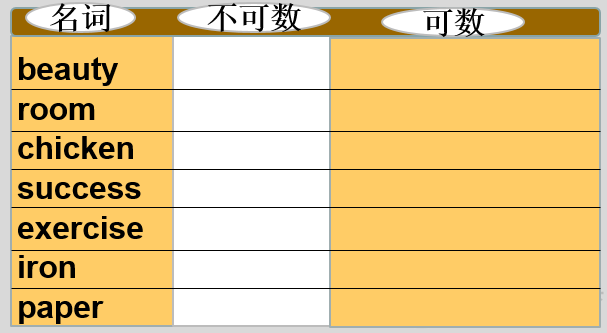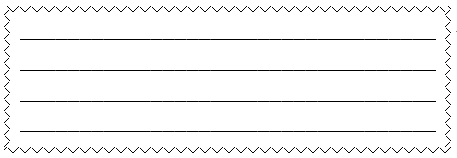第一讲:名词
一、名词的分类
|
名词 |
___________________ |
|
普通名词 |
___________________ |
___________________ |
|
___________________ |
|
___________________ |
___________________ |
|
___________________ |
1. 专有名词
表示____________________________________________________。
如: Tom, Peking University, the United Nations
特性:
① __________________________________________。
② __________________________________________。
2. 普通名词
泛指__________________________________________。
如: student, actor, money
分为:
可数名词 如:_________________________
不可数名词 如:__________________________________
可数名词包括:
个体名词:________________________________________________
如:garden, actor, hammer
集体名词:________________________________________________
如:family, class, staff, team
集体名词做主语时谓语动词用单数还是复数?
如:My class _______________(be) rather noisy yesterday.
The audience_ _____________________________________________
The staff is/are against the plan.
强调集体:动词用__________
如:His family is very large-he has three sons and two daughters.
强调个体:动词用_________
如:My family ______________________.
有些集体名词做主语时动词只用复数: ________________________________
如:The police ______________________________.
The cattle_______________________________________
不可数名词包括:
物质名词:表示__________________________________________
如: cotton, water, ink, wood
抽像名词:表示_______________________________________________
如:_______________________________________________________
物质名词的特殊情况
1. 有些可用作可数名词表示:________________________
如:_____________________________________
He can’t drink much. _____________________________________.
_________________________________________________
2. 部分物质名词的复数形式__________________
如:The island _________________________________________.
waters__________________________
Villagers are __________________________________________________.
rains 雨季 sands沙滩 woods森林
部分物质/抽象名词可作个体名词,但含义不同

二.名词的数
1. 规则名词复数的构成
(1) ___________
如:cook—_____________, canal—_____________, monkey—______________
(2) __________________________
如:bus—_____________, brush—_____________, coach—_____________
注意:以s结尾的专有名词:_____________
如:Charles-______________________
(3) ________________________
如:story—_____________, county—_____________
注意:
① 以元音字母+y结尾:_______________
如:
boy—_____________, ray—_____________, bay—_____________
② 以y结尾的专有名词:____________________
如:Mary—_______________
January—______________________
(4) 以o结尾的名词。
①__________________
如:radio—_____________, photo—_____________, kilo—_____________, zoo—_____________, piano—_____________, bamboo—_____________, studio—_____________
② __________________
如:mosquito—_____________, hero—_____________
tomato—_____________, potato—_____________,
③ 两种情况均可
如:zero—___________________, motto—_____________________,
volcano—__________________________
(5) 以f/fe结尾的词
① ________________________________
如:___________________________________________________________________

② ________________________
如:roof—_____________, gulf—_____________, safe—_____________,
chief—_____________, belief—_____________, cliff—_____________
grief—_____________, proof—_____________
③ 个别有__________________
如:scarf —_____________handkerchief—_______________________________,
hoof—_____________, dwarf—_____________ 
2.不规则名词复数的构成
(1) ________________
如: man—_____________, goose—_____________, tooth—_____________
(2) ________________
如:_______________________________________________________
(3) ____________________
如:mouse—_____________, child—_____________, medium—_____________,
bacterium—_____________, ox—_____________, phenomenon—_____________
3. 复合名词复数的构成
(1) _____________________________________
如:shoe-repairer—_________________, mother-in-law—____________________,
passer-by—_________________, looker-on—____________________
editor-in-chief—_____________________, green-hand—____________________
(2) _____________________________
如:forget-me-not—_____________, good-for-nothing—_____________
merry-go-round—____________________, press-up—____________________
has-been—_________________
(3) ________________________________________________________。
如:man cook—_____________, woman writer—_____________
注意:boy/girl student—_________________
4. 字母、符号、数字等:__________
如:______________________________________________
______________________________________________
5. “某国人”的单复数变化:
___________________________________________________
如:
Chinese—_____________ Japanese—_____________ Swiss—_____________
Englishman—_____________ Frenchman—_____________
American—_____________ Australian—_____________ Canadian—_____________
Korean—_____________ Russian—_____________ Indian—_____________
German—_____________
注意:
1. 有些名词习惯以复数形式出现:
_____________________________________________________________________________
_____________________________________________________________________________
2. 部分名词在短语中习惯以复数形式出现:
______________________情绪高昂/低落
______________________为……做准备
______________________轮流(做某事)
______________________努力做某事
______________________收支平衡
______________________同……保持联系
______________________修理;修补
三.名词所有格
名词所有格表示_______________。
如:________________________________________

1.’s所有格
(1) 构成
在名词后加_________,词尾有______________________
如:________________________________________________________________________
注意:________________________________________________
(2) 运用
① 多用于_________________________________
如:______________________________________
② 也可用于________________________________________________________
如:______________________________________________________
______________________________________________________
_______________________________
比较:
________________________________
________________________________
(3) ’s所有格后名词的省略
① _______________________________
如:_____________________________________.
② ______________________________________________________
如:_______________________________________
_______________________________________
2. of所有格
① 多用于_____________________
如:________________________________________
__________________________________
② 也可用于______________________
如:______________________________________________
_________________________________________________
(3). ’s所有格和of所有格的比较
① _____________________________
如:the name of that plant=_________________________,
senior members of the club=____________________________________
② _________________________________
如:______________________, _________________________
③ ________________________________________________________
如:________________________________, _________________________________
3. 双重所有格
双重所有格:_____________________________________________________________
如:______________________________, _________________________________
四. 不可数名词的量化表达
(1) 用_____________________________________________________________________等表示
如:
___________________________________________________________________
___________________________________________________________________
(2). 用_______________
如:
__________________________________________________________________
(3) 用___________________
如:
__________________________________________________________________
___________________________________________________________________
五.名词的语法功能
1. 作__________
如:______________________________.
2. 作__________
如:I like _______________.
_____________________________.
3. 作___________
如:___________________________.
4. 作___________
如:____________________________.
5. 作_____________
如:____________________________.
注意:______________________________________________________________
如:_________________________________________________________________________
6. 作_____________
如:__________________________.
__________________________.
7. 名词作定语的注意事项:
(1) _____________________________
如:__________________________________________
(2) ______________________________________________________
如:______________________________________________________
______________________________________________________
_________________________________________________________
注意:_________________________________________
(3) _______________________
如:__________________________________________________________________________
 您现在的位置: 奥风英语 > 高考英语 > 高考语法完全突破视频教程 > 正文
您现在的位置: 奥风英语 > 高考英语 > 高考语法完全突破视频教程 > 正文